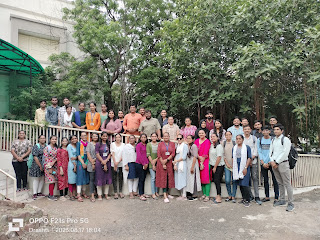In this blog, I want to write about my experience at a photography workshop. It was August 17th, 2023, when I got to attend a Photography Workshop at the Department of English at MKBU. We learned many new things during this workshop, and it was led by a famous Wildlife Photographer and Filmmaker, Mr. Kaushik Ghelani. These workshops are not just about technical stuff; sir also helps us be more creative and understand the art better. I'll take you through what happened that day and how it made me look at photography in a whole new way.
The Art of Storytelling with Photography:
Photography is the exquisite art of encapsulating moments, emotions, and narratives within the confines of a single frame. It's a symphony of light and shadow, a canvas where reality is painted with creativity, and a testament to the beauty that surrounds us.
In today's world full of pictures, telling stories through photos is like painting with light. It's a way to take people on journeys, make them feel things, and let their imagination run wild. It's not just about clicking pictures; it's about creating an experience that sticks with you. Every good photo story has a main idea or message. It's like the captain that steers the ship, guiding the choice of photos and their order. Whether it's about the innocence of kids, the beauty of nature changing, or how strong a community is, this main idea holds everything together. Pictures need a good layout, like arranging notes in music. Trying different angles and lights adds spice to the story. After clicking, a bit of editing can make pictures feel just right. And if photographer write short lines about the pictures, it helps people understand better.
The workshop had a two sessions. It starts with a warm welcome to Mr. Kaushik and students from the Life Science department. Trushali Dodiya anchored the program After that, Riya Bhatt made the atmosphere cheerful by a floral welcome. Avani Jani gave an introduction about Kaushik Ghelani sir. She also shared lines written by Dhruv Bhatt. In a previous workshop, Mr. Kaushik told us that Dhruv Bhatt gave him the name "આરણ્યક". This realization emphasizes the clear link between wildlife photography, the art of photography, and the world of literature.
In the workshop, Kaushik Sir taught us various rules of photography. Here, I'll share what I learned about these rules.
1. Rule of Third:
This principle encourages us to divide our image into nine equal parts using two horizontal and two vertical lines. Placing the main subject off-center along these lines can add depth and visual interest to our composition. Sir also talks about how to set the foreground Midgeound and background in photography.
2. Symmetry:
In architectural photography, symmetry plays a pivotal role. By arranging elements in a balanced manner, either horizontally or vertically, we can create a harmonious and captivating image. Using symmetry in nature photography can create captivating and visually appealing compositions that highlight the inherent beauty and balance found in the natural world.
3. Geometric Shapes:
Incorporating geometric shapes like lines, circles, squares, and triangles helps to provide structure and organization to our photos. These shapes can guide the viewer's eye and add aesthetic appeal.
4. Center Focus Rule:
Placing the primary subject at or near the center of the frame can create a strong visual impact. This technique draws immediate attention and can be particularly effective in certain situations.
5. Breathing Space:
Allowing extra space around the subject gives our composition room to "breathe." This technique can make the image feel more dynamic and engaging, preventing it from appearing too cluttered.
6. Lead Room:
When capturing subjects in motion, providing additional space in the direction they are moving can create a sense of movement and direction, adding energy to the image.
7. Ground Photo:
Ground photography could refer to capturing landscapes, focusing on the ground itself, terrain, natural elements, and features such as mountains, valleys, deserts, forests, and more.
8. Head Room:
Leaving space between the top of a person's head and the upper edge of the frame is crucial, especially in portraits. This ensures a balanced composition and prevents the subject from feeling cramped. These are some rules which are important for photography.
In the practical session, we had the chance to put these rules into action as we roamed the university campus, capturing images that reflected our creative perspectives. The next session focused on identifying mistakes in our photos and learning how to improve our photography skills. This hands-on approach helped us understand and remember these concepts better. This combination of theory and practice allowed us to grasp these concepts more effectively and apply them to our own work. In the workshop i got the chance to take some photos. It was my first time roaming around the campus and taking pictures. I did my best to capture the scenes. Here, I would like to share the photos I took:
Out of the entire group of students, Kaushik sir selected six students whose photography skills stood out. Then he decided to give a special ranking to the top three students who took the best pictures based on the quality of their captured photos. To recognize their exceptional work, these three students were awarded prizes, serving as a source of encouragement.
- Avani Jani
- Bhumiba Gohi
- Drashti Joshi
- Rajeshvariba Rana
- Dhruvi
- Prabhatsinh Bhandari
I would like to extend my heartfelt thanks to Dilip Barad sir, for his unwavering encouragement towards helping students discover new horizons. Additionally, my sincere appreciation goes to Vaidehi ma'am for her efforts in coordinating this invaluable workshop.
Thanks for visiting my blog!
Words - 934



















No comments:
Post a Comment